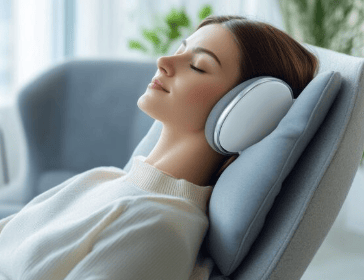In the search for calm, many people are turning to something simple—but powerful: the breath. Breathwork is quickly becoming a go-to tool for managing stress, anxiety, and emotional overwhelm. It’s natural, free, and doesn’t require any special equipment.
This practice isn’t new. Ancient traditions like yoga and qi gong have used conscious breathing for centuries. Today, modern neuroscience confirms what those traditions knew—that how we breathe directly affects how we feel.
From calming the nervous system to improving focus and mood, the benefits of breathwork are wide-reaching. And perhaps most importantly, anyone can do it. Whether you’re sitting at your desk, lying in bed, or walking outside, your breath is always with you—ready to reset your mind and body.
In this guide, we’ll explore how breathwork for mental health works, what the science says, and how you can begin using it today. If you’re looking for a simple, empowering way to care for your mind, this is a great place to start.
What Is Breathwork?
Breathwork is the practice of consciously controlling your breath to shift how you feel—mentally, emotionally, and physically. It’s simple in concept, yet deeply powerful. By changing your breathing pattern, you can calm your mind, energize your body, or release emotional tension.
There are many types of breathwork, each with different goals and techniques. Some are gentle and grounding, while others are intense and transformational. Common approaches include:
- Box breathing: A balanced method where you inhale, hold, exhale, and hold again—each for 4 counts. Popular with athletes and in high-stress settings.
- Diaphragmatic breathing: Also called belly breathing, it helps activate the parasympathetic nervous system for relaxation.
- 4-7-8 breathing: Inhale for 4 counts, hold for 7, exhale for 8. Known for reducing anxiety and helping with sleep.
- Holotropic breathwork: A more intense style often used in therapeutic or spiritual settings, involving rapid, deep breathing.
Breathwork is used in therapy, meditation, yoga, and even elite performance coaching. Whether you’re managing anxiety, preparing for a big moment, or just need a mental reset, breathwork offers a flexible, effective tool you can use anytime, anywhere.
Key Mental Health Benefits of Breathwork
When it comes to taking care of your mental health, breathwork is one of the simplest and most powerful tools available. By learning to consciously control your breathing, you can influence everything from your mood and focus to how you respond to stress and trauma. Let’s break down the key ways breathwork supports psychological well-being.
A. Reduces Stress & Cortisol
Stress is a part of life—but how we handle it makes all the difference. Breathwork helps reduce stress by activating the parasympathetic nervous system, also known as the body’s “rest and digest” mode. This shifts your physiology out of the fight-or-flight state, slowing your heart rate and calming your mind.
Studies have shown that slow, intentional breathing can lower cortisol levels, the body’s main stress hormone. Techniques like diaphragmatic breathing are especially effective at helping the body unwind after a long day or during periods of high tension.
B. Calms Anxiety & Panic
For those struggling with anxiety or panic attacks, the breath becomes both a lifeline and an anchor. Rapid breathing often comes with anxious thinking. Breathwork can interrupt this cycle.
Practices like box breathing or the 4-7-8 method are frequently used to ground the body during moments of overwhelm. These structured techniques slow the breath, regulate heart rate, and help quiet racing thoughts—offering immediate relief without the need for external tools.
Breathwork has even been used alongside cognitive behavioral therapy (CBT) to improve treatment outcomes for anxiety disorders.
C. Enhances Emotional Regulation
Our emotions are often felt first in the body. Breathwork helps build awareness of internal states and creates space between a trigger and our reaction. In other words, it helps us respond more thoughtfully instead of reacting impulsively.
Certain breath practices allow for emotional release—letting go of stored tension or grief that’s been sitting under the surface. Over time, this contributes to better emotional resilience and improved self-awareness.
D. Improves Focus & Clarity
The brain thrives on oxygen. When we breathe deeply and fully, we increase oxygen flow to the brain, which supports better mental clarity and sharper cognitive function.
Breathwork techniques have been linked to improvements in attention, executive functioning, and even working memory. In performance settings—like sports or public speaking—controlled breathing is often used to calm nerves and stay mentally sharp under pressure.
If your mind feels scattered or fatigued, a few minutes of focused breathwork can provide a reset that’s both energizing and grounding.
E. Supports Trauma Recovery
Breathwork is now widely used in trauma-informed therapy and somatic healing. For people who’ve experienced trauma, the nervous system often gets stuck in survival states—like freeze or hypervigilance.
Somatic breathwork gently helps regulate the body’s fear responses, allowing clients to reconnect with their bodies in a safe, controlled way. It can also release physical patterns of bracing, tension, or shutdown that have become habitual.
While breathwork isn’t a standalone treatment for trauma, when practiced with proper support, it can be a powerful complement to therapy.
F. Boosts Mood & Mindfulness
The breath is a direct gateway to the present moment. Every conscious inhale and exhale draws attention away from mental chatter and back into the here and now. This simple act of awareness is the foundation of mindfulness.
Beyond presence, certain breath patterns can trigger the release of feel-good neurotransmitters like serotonin and dopamine. Fast-paced practices like breath of fire or conscious connected breathing often leave people feeling lighter, more uplifted, and emotionally refreshed.
For those looking to build more daily mindfulness or emotional balance, breathwork is a practical, low-barrier place to start.
Whether you’re looking for stress relief, emotional healing, or support with anxiety, breathwork offers a powerful, science-supported way to feel better—one breath at a time. It’s a tool that meets you where you are and grows with you as your needs evolve.
How Breathwork Works: The Science
The calming power of breathwork isn’t just psychological—it’s deeply physiological. When you slow down and control your breathing, you activate a series of biological systems that help regulate mood, reduce anxiety, and restore balance. Here’s what modern science reveals about how breath affects the brain and body.
Vagus Nerve Stimulation and Nervous System Balance
One of the key players in breathwork’s therapeutic effects is the vagus nerve, a major part of the parasympathetic nervous system. Deep, slow breathing—especially diaphragmatic breathing—stimulates the vagus nerve, which in turn slows heart rate, reduces blood pressure, and promotes a sense of calm and safety.
According to a 2018 article in Frontiers in Psychiatry, vagal nerve activity is directly linked to emotional regulation, stress resilience, and overall mental well-being. By breathing with intention, we’re tapping into the body’s built-in system for stress relief and nervous system reset.
Brainwave Changes and Neurochemistry
Breathwork also affects brain activity. Specific patterns, like box breathing or 4-7-8, help shift the brain from high-alert beta waves into more relaxed alpha and theta states—the same waves activated during meditation and deep rest.
In a study published in Brain Sciences, slow-paced breathing was shown to alter connectivity in brain regions linked to attention, mood, and self-awareness. These changes are tied to increased mindfulness, better focus, and reduced reactivity.
Breathing also balances oxygen and carbon dioxide levels in the blood. This balance is essential for maintaining cerebral blood flow, which supports mental clarity and emotional stability.
Backed by Psychology and Neuroscience
Research in psychology continues to validate breathwork’s mental health applications. Studies have shown improvements in symptoms of anxiety, depression, PTSD, and burnout following structured breathing interventions.
In short, the science of breathwork bridges ancient wisdom and modern medicine. It’s a simple but powerful way to regulate both body and mind—without needing a prescription.
How to Start a Breathwork Practice
Starting a breathwork practice is easier than you might think. You don’t need fancy equipment or hours of free time. Just a few minutes of intentional breathing each day can lead to real mental and emotional shifts.

Begin Small and Simple
Start with 5–10 minutes a day. Choose a beginner-friendly technique like:
- Box breathing (inhale–hold–exhale–hold for 4 seconds each)
- 4-7-8 breathing (inhale for 4, hold for 7, exhale for 8)
- Alternate nostril breathing (used in yoga to balance energy and focus)
These techniques are easy to learn and work well even in the middle of a busy day.
Best Times to Practice
- Morning: Set a calm tone for your day
- During stress: Ground yourself quickly when overwhelmed
- Before sleep: Slow your mind and prepare for deeper rest
Breathing works best when it becomes a regular habit—not just a reaction to stress. Make it part of your routine like stretching or journaling.
Try a Breathwork App
Apps like Othership, Breathwrk, Calm, or Insight Timer offer guided sessions tailored to mood, energy level, or time of day. They’re great for beginners looking for structure and support.
Know Your Body
While breathwork is safe for most people, those with trauma, asthma, or cardiovascular issues should start gently and consider consulting a therapist or doctor before diving into deeper practices.
With just a few mindful breaths a day, you can begin unlocking the power of breath to calm, center, and uplift.
>>Related: Top Holistic Wellness Practices of 2025: Mind, Body & Spirit
FAQs: Breathwork Effectiveness and Safety
Can breathwork really reduce anxiety fast?
Yes—many people feel relief within just a few minutes. Techniques like box breathing or 4-7-8 work by calming the nervous system and lowering your heart rate. They can be especially effective during moments of panic or stress by creating a sense of control and grounding.
What’s the best breathing technique for stress?
There’s no one-size-fits-all answer, but diaphragmatic breathing, box breathing, and alternate nostril breathing are great for beginners. Each encourages slow, deep breaths that signal safety to the body. Try a few to see what works best for your mind and lifestyle.
Is it safe to do breathwork every day?
Yes, for most people, daily breathwork is completely safe and beneficial. Start gently, especially if you’re new. If you have asthma, cardiovascular issues, or a trauma history, it’s wise to consult a healthcare provider before exploring more intense forms like holotropic or conscious connected breathing.
How long until I notice results?
Some benefits, like reduced tension or improved focus, can show up immediately. More lasting effects—like better sleep, mood balance, or emotional regulation—often appear with consistent practice over a few weeks.
Conclusion: Your Breath, Your Reset Button
Breathwork is one of the simplest yet most powerful tools for supporting emotional and mental wellness. Backed by both ancient wisdom and modern science, it offers real relief from stress, anxiety, and overwhelm—no medication, no equipment, just your breath.
What makes it so impactful is also what makes it so accessible. Anyone can start. Anywhere. Anytime.
Whether you’re navigating a tough day or building a long-term wellness routine, mental health through breath is a practice that meets you where you are.
So take a few minutes today. Breathe in with intention. Breathe out the noise. Start small—and let your breath guide you toward balance, clarity, and calm.
